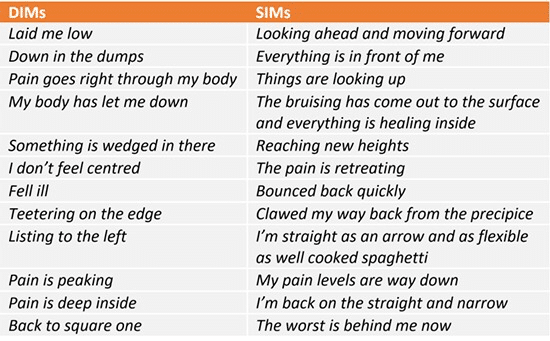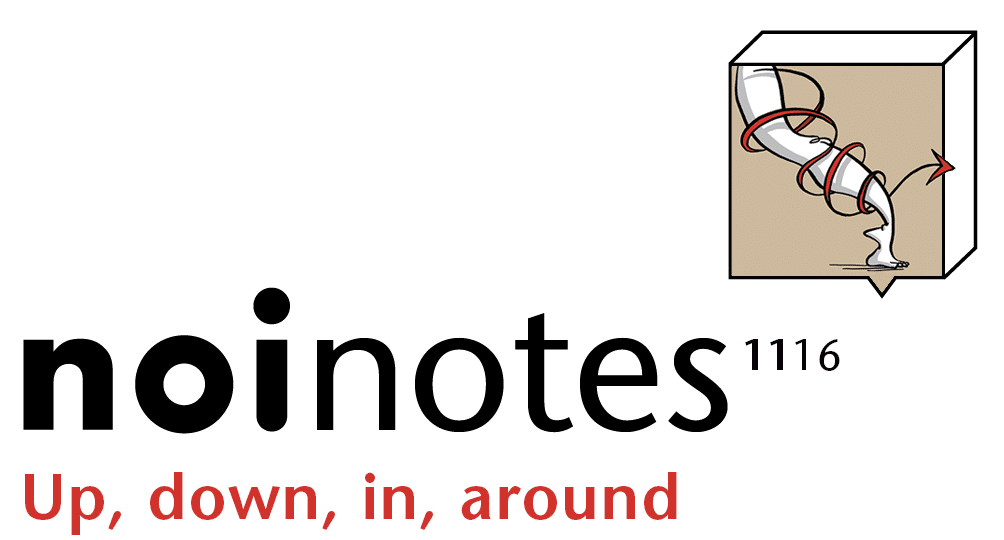Lorimer and I have finally left our new book Explain Pain Supercharged at the typesetters. It has been quite a trip over the last 5 years – and one area that we have indulged in quite a bit is the relationships between neurotag theory and modern neuroscience concepts of metaphor. Lakoff and Johnson’s seminal text Metaphors We Live By really did start something of a revolution. A common metaphor, say my back is stuffed, is held as a powerful and influential conceptual neurotag, most likely arising from a primary metaphorical concept held widely in society such as LOW BACKS ARE FRAGILE.
We both believe that societal and personal transformative language is as important as transformative movements in health; indeed both should be used together. Here are a few thoughts and examples of what we are on about with metaphor in Explain Pain Supercharged.
Metaphors are all around us
There are many different kinds of metaphor and they lurk everywhere. Read the quote from a patient below, and see how many metaphors you can pick:
‘The pain can be a real killer. It goes around and down the inside of the driver muscle and into my old knee which I stuffed up years ago. Sometimes it goes into my right ball. That drives me crazy. I get pins and needles in the bloody right foot too. I can’t put my finger on why it’s happening, but I am ready for the scrapheap! The treatment so far has been bullshit.’
There are between 20 and 30 metaphorical statements in the quote above depending on who you are arguing with! (Clue – the pain is metaphorical.) But before we chat on, reflect for a moment on the beauty of metaphor as a communication tool. A vast amount of medical information has been expressed by a nonmedical person through this short statement – everything from anatomical, diagnostic, psychological and prognostic information and even a blunt view of the health system. It has also facilitated discussion of more intimate issues such as testicle pain and the statement has opened negotiations. The patient is talking in language that he believes both he and the health practitioner can understand and thus it invites discussion and adaptation. Therein lies the power of transformative metaphor.
Some metaphors help orientate
One kind of metaphor that helps make up the numbers above are orientational metaphors such as goes around and down or goes into. Many of us have probably forgotten that this is metaphorical language, but so did we before we got into this stuff. We have been collecting and researching these metaphors for some years now and there are dozens of these orientational metaphors used in health.
Orientational metaphors can be very useful diagnostically. Down and around and into or it goes from here to here may provide information about a known neural zone such as a dermatome. Equally pressure deep in my chest going up to my jaw should raise suspicions of heart ischaemia. But orientational metaphors such as in, around, down under and up may also allow sufferers to get a grip on a problem – the metaphor allows expression in language that both patient and clinician understand. But of course we know that pain can’t go anywhere – it doesn’t travel by bike or boat or plane. Believing that pain physically moves can reinforce a false relationship between tissue damage and pain, and so sometimes we may need to deconstruct this.
Transformational language – UP IS GOOD and DOWN IS BAD
Below is a sneak peak at a table from Explain Pain Supercharged. These are orientational statements, usually metaphors and we have classified them as DIMs (Danger in Me) neurotags and SIMs (Safety in Me) neurotags. Notice how the notion of up in orientational metaphors is usually linked with positive conceptualisations – on top of it all today; upbeat, and notions of down are usually more negative – fell ill; down in the dumps. This pattern has always been strong in health where primary metaphors are HEALTH IS UP and LIFE IS UP as well as SICKNESS IS DOWN and DEATH IS DOWN (Lakoff and Johnson 1980).

An awareness of these primary orientational metaphors offers opportunities for DIM (Danger in Me) neurotags to SIM (Safety in Me) neurotag transformations and also enhancement of the language of SIMs. By including up, front and forward in metaphorical language offered back to learners we promote the positive or put simply, we promote SIMs. Other positive metaphorical language might include goal, reach and balanced. Avoid negative metaphorical language for example under, out, imbalance and behind because they promote the negative – or promote DIMs. Just when it’s looking all neat and tidy, things are more complicated then they seem – it’s usually a good thing to be under control – see how this breaks the ‘rules’? Metaphors are clearly malleable.
So, metaphors can be helpful clinical descriptors, but also may have the power to perpetuate a pain neurotag. We go into the neuroimmunological consequence of negative and positive conceptual neurotags in the book. For now, best we be aware, identify, deconstruct and dethreaten them – and when able, turn a DIM metaphor into a SIM.
As always, thoughts and comments welcome below
-David Butler
THE 2017 NOI CALENDAR IS SHAPING UP, HERE ARE THE CONFIRMED DATES
Melbourne 31 March – 2 April EP and GMI
Adelaide 26-28 May EP and GMI
Darwin 4 – 6 August EP and GMI
Brisbane 25 – 27 August EP and GMI
Newcastle 8-10 September EP and GMI
Details and dates coming soon for Wollongong and Sydney
Check out our courses page for details and to enquire
David Butler is heading to the UK and Europe in 2017
Eemnes, Netherlands – Explain Pain and Graded Motor Imagery April 22-24
York, England – Explain Pain April 26-27
Check out our courses page to make an enquiry
HAVE YOU DOWNLOADED OUR NEW PROTECTOMETER APP YET?



Brilliantly written and exposed. Thank you. The power of positive language. When we use negative language, it is as if we are verbally abusing ourselves. I for one, have endured enough verbal abuse over the years and don’t need to perpetuate it by verbally abusing myself with negative language. I endeavour to use positive affirmations every day and trust that doing so will have a positive outcome.
Hi David,
Do you think the relationship of the metaphor/language utilised and the DIM/SIM appraisal overlaps somewhat with the express of emotion and valence appraisal? (Wiech & Tracey 2009).
If so. this would tend to support a view that pain could potentially be considered as a homeostatic/allostatic emotion, as suggested by Craig (2003). I would be most interested to hear your view on this concept.
Max
Craig AD. A new view of pain as a homeostatic emotion. Trends in Neuroscience. 2003; 303-307.
Wiech K & Tracey I. The influence of negative emotions on pain: Behavioral effects and neural mechanisms. Brain Body Medicine. 2009; 3:987-994.
Hi Max,
I am always wary making broad comments about what pain might be, especially on a hot Sunday night, but I am really open to the view of pain as a homeostatic emotion/construction/production/whatever. All the pathways involved in pain are homeostatic , the DIM SIM thinking does presume something of a neuroimmunological balance and of pain does involve a motivational element to make us change behaviour as do other homeostatic systems.
I think that one of the advantages of considering pain as homeostatic is that is directs us to embrace other homeostatic systems and their interactional loops and perturbations as part of a pain construction and thus allows a wider view than the current focus on central sensitisation.
Cheers
David
Hi David,
Super interesting, thanks for clarifying.
I wonder if such an approach will subsequently facilitate an even better understanding of the subsystems/processes which comprise central sensitisation.
Max
Thank you, keep up the great work. Looking forward to the Supercharged version. Interestingly I have been reading “Mastering the Clinical Conversation :Language as intervention” byM&J Village & Sydney Hayes
Thanks for the reminder David – I haven’t read it but I will.
David
My physio put me onto Explain Pain, bless her. Over time I relabelled my problem as a ‘stiff back’. That’s something I’m kinda in control of by working out five days a week. And one of these days I’ll just need to stand in the gym carpark for a minute and the stiffness will go :-}